Last month’s installment of the stories of the early families of Westminster Park detailed the history of the cottage built by John Chester Gallup, M. D. and his equal partner, James H. Bronson. We learned that Dr. Gallup died in 1884 and willed his share of the cottage to his wife, Marilla Houghton Gallup. Upon her death in 1894, Marilla willed that share to her niece, Rosa Houghton Goss and her husband Rev. Charles Frederic Goss. The half-share owned by James Bronson was lost to the bank in an economic downturn in 1897. At that time, Rev. Goss bought that half-share from the bank for $150. and the cottage was wholly owned by the Goss Family until 1920. 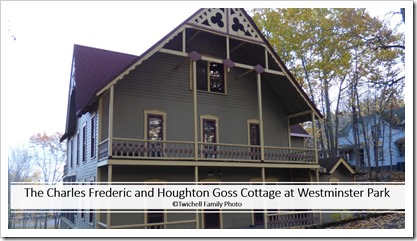
Rosa Houghton Goss (1854- 1922) descended from a highly esteemed New England family, the Houghton’s. Her father, Reverend Daniel Clay Houghton, was the editor of the “Genesee Evangelist” and of the “American Presbyterian”, two well-known Presbyterian publications. Rev. Houghton and his wife, Julianna Alton Houghton, both died when Rosa was a young child. Rosa came to live with her aunt, Marilla Houghton Gallup, in Clinton, New York, and was educated at the Houghton Seminary. In the Clinton community, she met Charles Frederic Goss, a student at Hamilton College.
Charles Frederick Goss (1852-1930) also came from an established American family. His great-grandfather had fought in the American Revolution. Goss’s father, Simon Sartwell Goss, was a Presbyterian minister in the Meridian and Cato, NY area. He also served in the Civil War from 1862-1863. He and his wife, Mary, had three children: John, Charles Frederic, and Clara Elizabeth “Libbie” Goss. (A side note: Libbie married Rev. Melancthon Woolsey Stryker who became President of Hamilton College. Rev. Stryker and family often visited Westminster Park over the years. Stryker also served as a pall bearer at the funeral of Marilla Gallup.) As we read about these families, we see a strong network of friends, relatives, classmates, business associates, etc. that populated Westminster Park. 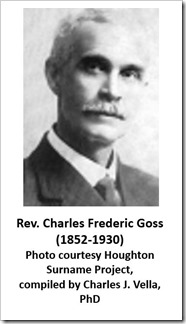
Rev. Goss attended Hamilton College, Clinton, New York. He graduated in 1873 with a degree of Bachelor of Arts. He then attended Auburn Theological Seminary in Auburn, New York graduating in 1876. After graduation and his ordination as a Presbyterian minister, Goss married Rosa Houghton. His first ministerial assignment was in Weatherford, Texas where he had charge of the Home Mission of the Presbyterian Board. After a year and a half, he accepted a position in Pennsylvania as the pastor of the Kendall Creek Presbyterian Church. In 1881, he was called to the Bethany Presbyterian Church of Utica, N.Y. His oratorical skills were noted at a conference organized by renowned Evangelist Dwight L. Moody, of Chicago, Illinois. Rev. Moody immediately offered Rev. Goss a position in Chicago at the Chicago Avenue Presbyterian Church. Goss served there until 1894 when he accepted his final ministerial assignment as pastor of the Avondale Presbyterian Church, Cincinnati, Ohio. Throughout his career, he was highly regarded as a preacher, speaker and author in the Presbyterian world.
Charles Frederic Goss had a passion for writing of all genres and what a prolific writer was he! Rev. Goss wrote a column entitled “The Optimist” for the “Cincinnati Commercial Tribune”. The columns were so well-received that they were published as a book in 1897. He published many articles on religious topics. In 1902, Goss published a biography of Dwight L. Moody, the man who was instrumental in securing his appointment in Chicago. In his later years, Rev. Goss revealed a continued interest in history by editing and partially writing History Cincinnati, published in 1932.
Reverend Goss’s greatest fame came from a book he wrote in 1900, entitled The Redemption of David Corson. The story captivated American readers. The main character, David Corson, is a young Quaker preacher, a very religious and eloquent man. A traveling medicine show comes to town and Corson is recruited for his oratorical skills to join the fakir, Dr. Paracelsus Aesculapius. Corson meets and falls in love with Pepeeta, a beautiful young Spanish woman who had been kidnapped by a band of Gypsies and was adopted by Aesculapius. His captivation with her leads him to turn his back on his religious life. Corson becomes a “talker” for the medicine fakir. There are dramatic chapters where he and Pepeeta try to escape and the characters are caught up in a life-and-death struggle. Corson descends to a life of gambling and drinking. More high drama ensues but, at last, with the death of Aesculapius and the love of Pepeeta, Corson sees the errors of his ways and seeks his own redemption in the ways of his Quaker religion.
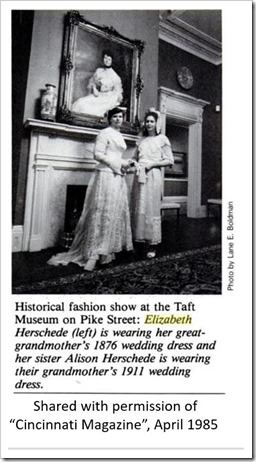 Such high drama enthralled America. The book was a best-seller. In 1906, the book was turned into a play by Mrs. Charlotte (Lottie) Blair Parker. It debuted on Broadway that year and 16 performances were run. By 1914, favor had not worn away, and the book was made into a silent film.
Such high drama enthralled America. The book was a best-seller. In 1906, the book was turned into a play by Mrs. Charlotte (Lottie) Blair Parker. It debuted on Broadway that year and 16 performances were run. By 1914, favor had not worn away, and the book was made into a silent film.
Even though life carried Rev. and Mrs. Goss to many locations in America, they found time to return to Westminster Park in the summers. In 1881, we read that Dr. John Chester Gallup, Rosa’s uncle, had plans to build a handsome boat house in the east fork of the Ferry Slip for Rosa and her husband. At that time Goss had a position in Bradford, Pennsylvania, but had plans to spend the summer at Houghton College. In 1882, there is a record that Rev. Goss preached at the Chapel in Westminster. That would have occurred in the original chapel built on Mount Beulah. In 1902, newspaper accounts reveal that the Goss Family summered in Westminster. Reverend Goss was to be in charge of all the religious services in the Chapel. In the year 1902, that would refer to the second chapel, built on the grounds of the Hotel.
Rosa and Charles began their connections to Westminster fairly early with the mention of the boathouse built for them by Dr. Gallup. But they are among the people who continued to come into the twentieth century and therefore, became more accessible to us. They are not just names in genealogy records or social columns, but bits and pieces of their life are still available. These are the records that bring our founders to life.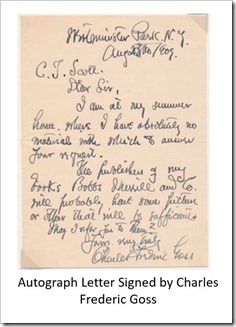
One search for the Goss family led me to “Cincinnati Magazine”. Their representative granted permission to share a photo and a tale of the Goss legacy from the twentieth century. In 1985, the Taft Museum of Cincinnati held a fashion show of historic garments. In the show, Elizabeth Herschede wore her great-grandmother’s 1876 wedding dress. The dress featured a pleated and puffed silk taffeta bodice with organdy skirt and sleeves. Who was her great grandmother? Rosa Houghton Goss. Her sister, Alison, wore the 1911 wedding dress of Rosa’s only daughter, Stella Goss Wohlgemuth. This gown had a satin and applique bodice and a satin skirt with panels of point d’esprit lace tied together with satin bows. What personal artifacts!
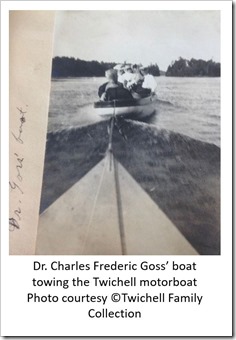 Ebay offered another tidbit. A dealer was selling a letter handwritten by C. F. Goss, from his Westminster Park home in 1909. Love his handwriting!
Ebay offered another tidbit. A dealer was selling a letter handwritten by C. F. Goss, from his Westminster Park home in 1909. Love his handwriting!
We also note a connection between the Goss family and my husband’s family, the Twichell’s. I will write about the Twichell family cottage in a future article, but I wouldn’t want to leave the Goss family without a few words about the apparent friendship between these two Presbyterian ministers.
In the early twentieth century, the Twichell armada consisted of various canoes, kayaks, and a trustworthy skiff that took them up and down the River. The Twichell’s also owned motorboats; they were not so reliable. We see photographic evidence of Reverend Goss coming to the rescue and towing one back to shore….
My friend quipped, “Reverend Goss could save your soul… and save your boat!”
Reverend Twichell and his wife Vera named their second son, “Goss”. I have never found any documentation that they named him after Charles Frederic Goss, but two clues suggest that they did. 1. We know that there was a friendship, and we cannot fail to note that Goss is an unusual name for a little boy. 2. Twichell family albums include photos of Rosa Houghton Goss holding little Goss Browne Twichell. From the expression on her face, I am guessing she might be holding a namesake. What do you think?
|
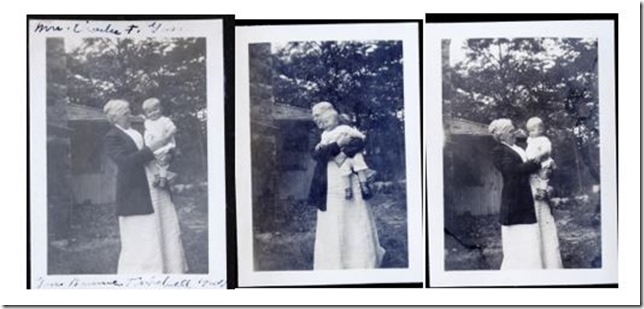
Rosa Elizabeth Houghton Goss (Mrs. Charles Frederic Goss) holding namesake Goss Browne Twichell. She looks rather fond of him!
Photo courtesy © Twichell Family Collection
|
©Linda Twichell 2018
Next month: the premier house of Westminster Park, the G. R. Hanford house.
Linda Lewis Twichell, a fifty-six-year resident of Westminster Park, has collected historical information on the Westminster community since the 1970’s. Presently, her research focuses on the lives of the people who settled here in the last quarter of the 19th century, and the cottages they built. A book of Westminster Park, its people, and their stories is in the works. Be sure to check out Linda’s other historical research published in previous issues of TI Life.